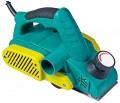Rotation speed
The maximum speed of rotation of the working tool of the electric planer — a drum with knives attached to it. In modern models, this figure is practically never lower than 10,000 rpm (otherwise it is impossible to ensure normal quality of work), and in most cases it is in the range of 11,000 – 17,000 rpm. It is believed that the higher the number of revolutions, the more evenly the workpiece is processed and the smoother the surface is obtained; and the overall speed of work will be higher. On the other hand, a high speed also requires high engine power, especially when working with hardwoods; for such materials, it makes sense to use a low-speed tool — it will provide more efficient power distribution.
Grooving depth
The greatest depth of the groove that can be cut into the workpiece with a planer.
Grooves are narrow and long slots used, in particular, for tenoning wooden parts. Some models of electric planers are equipped with special tools that make it easier to cut grooves.
V-grooves
The number of V-grooves provided in the design of the tool.
V-shaped grooves are located on the sole of the tool in the longitudinal direction. They are used to chamfer the corners of the workpiece, serving as a kind of guide: the tool is “put on” by the groove on the corner being machined and moves along the workpiece so that the corner constantly maintains contact with the groove. It is much easier to keep the planer level with this way of working than with a solid flat sole; this is especially true in cases where the workpiece cannot be turned "angle up" and the planer has to be kept in an inclined position.
Also note that this function is intended only for the first pass along the corner, then you have to work in the classical way, with a flat sole — however, with a sufficient depth of the V-shaped groove, the chamfer can be removed immediately, in the first pass. Actually, this is the point of having several grooves in the design — in such cases they have different depths and can be useful for different chamfer sizes. The maximum number of grooves found in modern electric planers is
three ; using more in a hand tool just doesn't make sense.
Knives
The design of knives intended for use with a planer and, usually, supplied as standard. The type of knives does not affect the performance of the tool, but in the case of dullness or nicks, the methods for correcting the situation differ significantly.
— Unilateral. As the name suggests, these knives are sharpened on one side only. If defects appear on the blade, it can be removed and sharpened or the edge straightened. Technically, such an operation can be carried out many times, but it requires not only time, but also appropriate skills and equipment.
—
Bilateral. Knives sharpened on both sides are very convenient due to the fact that when the edge becomes dull or serrated, it is enough to remove the knife and install it on the other side, with a “fresh” blade. On the other hand, such blades do not allow sharpening — when the second side of the knife becomes unusable, the only option is to replace it.
In box
—
Dust collector. The presence of a dust collector in the delivery set — a special bag for collecting dust, chips and other waste that occurs during operation. This bag connects directly to the waste chute, so that the waste stays in the dust bin and cleaning up after work becomes much easier. However the dimensions of the tool with the bag attached increase somewhat, and during work it is necessary to monitor its filling and release it in time — otherwise the accumulated chips can jam or even break the planer.
—
Case (bag). The presence in the delivery set of a special case — a suitcase for storing and carrying a tool, which also provides some degree of protection. Using a case for such purposes is much more convenient than various "non-native" packages: it is optimally adapted to a specific planer model, in addition, it often has specialized compartments for additional accessories. There are also rag bags, lighter, but at the same time less protective.

